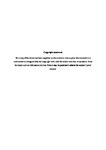Effects of dietary ingredients and feed additives on the health and production of European sea bass (Dicentrarchus labrax) for applications in aquaculture
| dc.contributor.supervisor | Merrifield, Daniel | |
| dc.contributor.author | Peggs, David Luke | |
| dc.contributor.other | School of Biological and Marine Sciences | en_US |
| dc.date.accessioned | 2015-11-24T12:55:10Z | |
| dc.date.available | 2015-11-24T12:55:10Z | |
| dc.date.issued | 2015 | |
| dc.date.issued | 2015 | |
| dc.identifier | 10145572 | en_US |
| dc.identifier.uri | http://hdl.handle.net/10026.1/3830 | |
| dc.description.abstract |
Experiment one revealed fishmeal (FM) replacement with soy protein concentrate (SPC) alone, and in combination with pea protein concentrate (PPC) and saponins (S) modulated the intestinal bacterial communities of D. labrax, increasing the presence of lactic acid bacteria. Intestinal histology revealed significantly reduced goblet cell’s (GC’s) in fish fed the SPC+S, epithelial microvilli densities (MD) in fish fed the SPC+PPC, SPC+PPC+S and SPC+S after two weeks feeding. Significant reductions in GC’s and intraepithelial leukocytes (IEL’s) in fish fed the SPC+S, and MD’s in fish fed the SPC+S and SPC+PPC+S after four weeks feeding, relative to fish fed the FM control. Furthermore, fish fed all plant based diets appeared to exhibit a loss of membrane integrity at the microvilli tips, most pronounced in fish fed the SPC+S diet. These results suggest a sub-acute enteritis response in the posterior intestine of D. labrax, which was deemed to be most pronounced in fish fed the SPC+S diets. Experiment two utilised the SPC+S diet as a sub-optimal basal diet to assess the potential of the probiotic Bacillus subtilis and the prebiotic Previda®, individually and in combination, in alleviating the enteritis-like effects induced by this diet, observed in the first experiment. Microbiological analyses revealed B. subtilis modulated the allochthonous bacterial communities. Fish fed the combination of B. subtilis and Previda® (synbiotic) diet exhibited a significantly increased intestinal perimeter ratio, compared to fish fed the basal. Significantly elevated GC’s in fish fed the probiotic and synbiotic treatments, and significantly elevated epithelial MD’s, and intestinal absorptive surface index in fish fed the probiotic diet was observed, relative to fed fish the basal. The loss of membrane integrity induced by the basal diet, was reduced in fish fed the probiotic, prebiotic and synbiotic diets. The intestinal gene expression of the pro-inflammatory cytokines IL-1β and TNFα was significantly up-regulated in fish fed all experimental diets, relative to fish fed the basal. The intestinal gene expression of HSP70, CASP3 and PCNA was significantly down-regulated in fish fed the probiotic, prebiotic and synbiotic relative to fish fed the basal. At the end of the experiment intestinal samples were exposed to one of four treatments [1. PBS (control), 2. B. subtilis, 3. Vibrio anguillarum and 4. B. subtilis + V. anguillarum], ex vivo, to determine if the feed additives could mitigate enteric pathogen damage. All feed additives revealed the potential to reduce the morphological damage caused by the pathogen. Experiment three assessed B. subtilis and the phytobiotic Next Enhance 150® on the growth and health of D. labrax. B. subtilis modulated the allochthonous bacterial communities and reduced the presence of some potential pathogens. The intestinal gene expression of HSP70, CASP3, PCNA and CAL was significantly down-regulation in fish fed the probiotic diet relative to fish fed the control. Significantly elevated IEL’s were observed in fish fed the probiotic and Next Enhance 150® diets relative to fish fed the control. Growth performance was remained unaffected. The present research demonstrates that dietary B. subtilis modulates the allochthonous bacterial communities, as well as, improving the intestinal morphology and localised immunity in European sea bass. Dietary Previda® and Next Enhance 150® were also observed to confer beneficial effects on the gut health of this species. No detrimental effects were observed as a consequence of any of the feed additives used in the present research. | en_US |
| dc.description.sponsorship | Novus International, Society for Applied Microbiology | en_US |
| dc.language.iso | en | en_US |
| dc.publisher | Plymouth University | en_US |
| dc.subject | Feed Additives | |
| dc.subject | European Sea Bass | |
| dc.subject | Aquaculture | en_US |
| dc.title | Effects of dietary ingredients and feed additives on the health and production of European sea bass (Dicentrarchus labrax) for applications in aquaculture | en_US |
| dc.type | Thesis | |
| plymouth.version | Full version | en_US |
| dc.identifier.doi | http://dx.doi.org/10.24382/4675 |
Files in this item
This item appears in the following Collection(s)
-
01 Research Theses Main Collection
Research Theses Main


